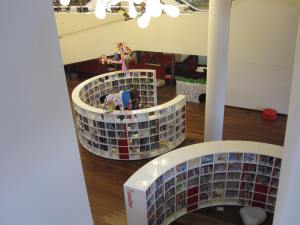The Amsterdam main branch is the largest public library in Europe, occupying a beautiful ten story building next to the central train station. Officially opened in July 2007, it offers several innovations, including a radio station and children’s section which uses a unique designed-by-kids classification system.
The children’s section is one story below the main entrance, but the ceiling is nearly three stories tall as it opens through the periodical section and the main floor. The open construction gives a feeling of space and makes it easy to find from the main entrance. What surprised me about this design is how little noise traveled up from the children’s section into the adult areas.
Classification
The open-concept layout showcases the unique design of the bookshelves. The shelves are all partial circles with the book spines facing inwards. While the shelves have the added benefit of creating an inviting, private reading area, this distinctive layout was chosen for more than the aesthetics; the semi-circles each represents a subject area in the the Library of 100 Talents classification system.
The system
The 100 Talents system, unique to the Netherlands, is based on the Reggio Emilia educational philosophy which views children as “beautiful, powerful, competent, creative, curious, and full of potential and ambitious desires.”1 Drawing on this idea of the child as a rational and capable actor within the library setting, the Dutch library association invited children to help create a unique classification system and to design an ideal library. The resulting system is used to classify materials for young adults and for children aged 7 and above. The subject areas are broad, with abstract titles such as “Me in the World”, “Adventure”, “Going Outside” and “Dreams.” These large categories are then subdivided into smaller topics. For example, a subdivision of “Me in the World” is “Me and You,” which covers topics like religion, sociology, and the human body.
Shelf organization
In each sub-section the books are ordered in the same way: first the non-fiction by SISO (Dutch equivalent of DDC) number, followed by fiction in alphabetical order, and finally all other formats including audiobooks, DVDs, and magazines.
The proximity of fiction and non-fiction works is designed to encourage children to discover more about topics that interest them, without requiring them to search in the catalogue and to look in several different physical locations. According to a Youth Librarian working in the department, children are easily able to use the system while adults, more accustomed to separate fiction and non-fiction sections, do not pick it up as quickly.
It seems to me that the main strength of this system is that it groups all materials on the same topic together while still using traditional notation (DDC and authors last name) for shelf organization. This greatly reduces the need for updates, as only new DDC numbers need to be added to the schedules, rather than every individual item. In addition, using traditional notation should allow users to easily switch between the 100 Talents organization and the traditional organization in other libraries. I was unable to find any further English language information on this topic, but it would certainly be an interesting study to see how easily children accustomed to the 100 Talents organization are able to find materials in a traditional library.
Final thoughts
As you might have noticed in the image gallery above, the colour scheme in the children’s section is quite adult when compared to the primary-colour inspired designs popular in North American children’s spaces. In fact, the colours in the children’s area (red and white with natural wood) are exactly the same as is used in the rest of the library, although some kid-centered decorative accents have been added.
Finally, I think it’s important to mention that the Amsterdam central branch is beautiful and massive library, covering 28,000 m2. Within the library there is a theatre that seats 250, a radio station, conference rooms, exhibition space, a music department, study pods, and a truly excellent rooftop café which provides a sweeping view of the city. If you ever visit Amsterdam, it’s well worth a visit- and is easy to find since it is a ten story buildilng next to the central train station.
1. Hewett, V.M. (2001). Examining the Reggio Emilia approach to early childhood education. Early Childhood Education Journal, 29(2), 95-100.
I would like to thank Ms. Skotarczak, Youth Librarian at the Amsterdam OBA, for her help in explaining the classification system.






